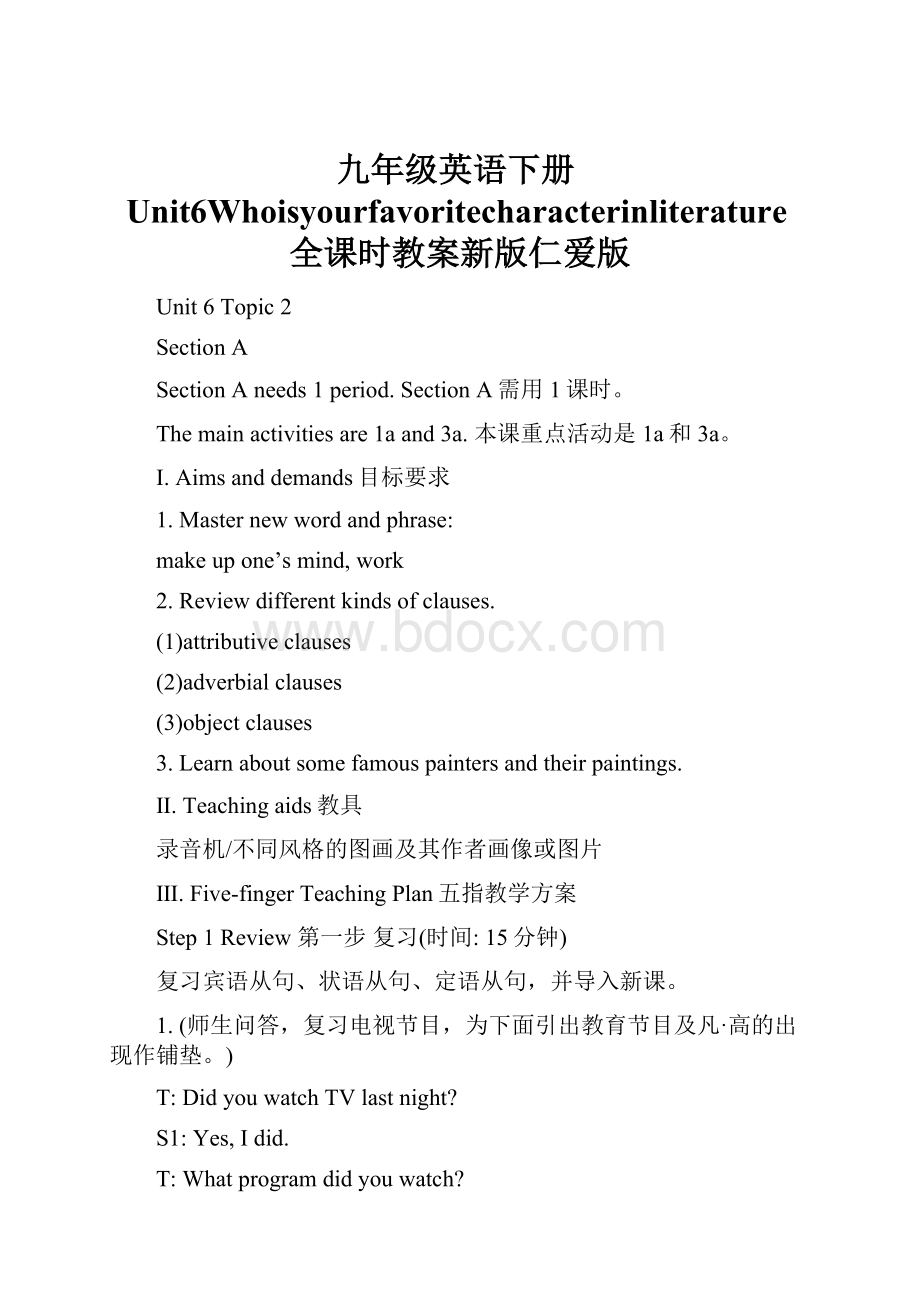九年级英语下册Unit6Whoisyourfavoritecharacterinliterature全课时教案新版仁爱版.docx
《九年级英语下册Unit6Whoisyourfavoritecharacterinliterature全课时教案新版仁爱版.docx》由会员分享,可在线阅读,更多相关《九年级英语下册Unit6Whoisyourfavoritecharacterinliterature全课时教案新版仁爱版.docx(33页珍藏版)》请在冰豆网上搜索。

九年级英语下册Unit6Whoisyourfavoritecharacterinliterature全课时教案新版仁爱版
Unit6Topic2
SectionA
SectionAneeds1period.SectionA需用1课时。
Themainactivitiesare1aand3a.本课重点活动是1a和3a。
Ⅰ.Aimsanddemands目标要求
1.Masternewwordandphrase:
makeupone’smind,work
2.Reviewdifferentkindsofclauses.
(1)attributiveclauses
(2)adverbialclauses
(3)objectclauses
3.Learnaboutsomefamouspaintersandtheirpaintings.
Ⅱ.Teachingaids教具
录音机/不同风格的图画及其作者画像或图片
Ⅲ.Five-fingerTeachingPlan五指教学方案
Step1Review第一步复习(时间:
15分钟)
复习宾语从句、状语从句、定语从句,并导入新课。
1.(师生问答,复习电视节目,为下面引出教育节目及凡·高的出现作铺垫。
)
T:
DidyouwatchTVlastnight?
S1:
Yes,Idid.
T:
Whatprogramdidyouwatch?
S1:
Iwatched...(让学生说出节目名称。
)
T:
Whatwasitabout?
S1:
Itwasabout...(让学生用自己的话描述节目内容。
)
2.(学生用相似的对话问教师,导入新课。
)
Ss:
DidyouwatchTVlastnight?
T:
Yes,Idid.
Ss:
Whatprogramdidyouwatch?
T:
Iwatchedaneducationalprogram.
Ss:
Whatwasitabout?
T:
ItwasastoryaboutVincentvanGogh.HewasafamousDutchartist.It’sapitythathediedwhenhewasveryyoung.Thecolorsinhispaintingsarebrightandbeautiful.
(板书画线部分,让学生们猜VincentvanGogh的中文名字,解释Dutch的英语意思,使学生们对凡·高有一定的了解。
)
VincentvanGogh:
Dutchartist
T:
“Dutch”meanspeoplefromHolland,languagespokeninHollandandotherthingsaboutHolland.Iwantsomestudentstosaysomethingaboutthegreatartist,VincentvanGogh,whocan?
Handsup!
(分别让几个同学单独说,然后大家一起说,学会对艺术家的描述。
)
3.(让一个喜欢艺术的学生回答教师的问题,引出对从句的复习。
)
T:
Doyoulikedrawing?
S2:
Yes.
T:
Whatdoyouknowaboutpaintings?
S2:
...
(让学生根据自己的情况说一些内容。
)
T:
Ifyouwanttolearnmoreaboutpaintings,youcangotoBeijingNationalArtGallery.
(板书画线部分,让学生朗读,并了解短语的含义。
)
BeijingNationalArtGallery
T:
Doyouwanttobeanartist?
Ss:
Yes,...
(引导学生做肯定回答。
)
T:
Whatwillyoudoifyouwanttobeanartist?
Ss:
...
(引导学生说一些做法。
)
T:
Yes.Ifyouwanttobeanartist,youmustworkveryhard.
(让其他学生模仿造句,教师总结观点。
)
S3:
Ifyouwanttobeanartist,youmustgotoartclasses.
S4:
Ifyouwanttobeanartist,youmustwatchthingscarefully.
S5:
Ifyouwanttobeanartist,youmustworkveryhard.
(板书画线句子,总结条件状语从句。
)
Ifyouwanttobeanartist,youmustgotoartclasses.
Ifyouwanttobeanartist,youmustwatchthingscarefully.
Ifyouwanttobeanartist,youmustworkveryhard.
T:
BeijingNationalArtGalleryisagreatplaceforyoutogo.Ifyoudon’tknowmuchaboutart,youcanasksomebodywhoknowsarttogowithyou.Ifyoudon’tknowtheway,youcanaskyourfriendswhoknowthewaytogowithyou.
(板书定语从句,并归纳。
)
Youcanasksomebodywhoknowsarttogowithyou.
Youcanaskyourfriendswhoknowthewaytogowithyou.
(引导学生们用含有定语从句的句子回答问题。
)
T:
Whocanyouasktogowith?
S6:
Icanasksomebodywhohasacartogowithme.
S7:
Icanasksomebodywhoishelpfultogowithme.
S8:
...
S9:
...
(找几个不喜欢艺术的同学,说出自己不喜欢的原因,引导他们用原因状语从句来表达。
)
T:
Doyouwanttobeanartist?
S10:
No,Idon’t.
T:
Why?
S10:
BecauseImustworkveryhard.
(教师对学生观点作出总结。
)
T:
Nowyouknowthatitisnoteasytobeanartist,youcandecidewhetherornotyouwanttobeanartist.Ifyoustillwanttobeanartist,youmustknowhowhardyoumustwork.
4.(点将比赛。
要求用以上所涉及的各种从句。
男女学生分为两组。
)
T:
Let’sdoacontest.Allthegirlsinonegroup:
G,alltheboysintheothergroup:
B.Youcanchallengethemembersoftheothergroup.
(第一轮,用if条件状语从句。
)
T:
Let’smakesentenceswith“if”.Iwillmakethefirstsentence.
(教师说出第一句,让第一个学生说第二句,第一个学生说完叫第二个学生。
)
T:
Iwillgototheparkifitisfinetomorrow.(T→B1)
B1:
Iwillgotoschoolifitisfinetomorrow.(B1→G1)
G1:
IwillgototheNationalArtGalleryifitisfinetomorrow.(G1→B2)
B2:
...
...
(第二轮,用定语从句。
)
T:
Ilikebookswhichhaveinterestingstories.(T→B1)
B1:
Ilikepaintingswhichhavebeautifullandscapes.(B1→G1)
G1:
…
…
(第三轮,用条件状语从句。
)
T:
××saidhewouldhaveagoodrestifhehadenoughtime.(T→B1)
B1:
Ifyouwouldn’tknowtheway,youcanaskyourfriends.(B1→G1)
G1:
…
…
(教师宣布结果,并给予奖励。
)
Step2Presentation第二步呈现(时间:
5分钟)
学习1a。
1.(就1a对话,进行简单介绍,然后设置听力任务,降低听力难度。
)
T:
Todaywe’lllearnsomethingaboutSteve,hewantstobeanartistlikeVincentvanGoghbecausehelikesVincentvanGogh’sworksverymuch.Nowlistenandfindtheanswerstothefollowingquestions:
(1)What’sthemostimportantthingsStevethinksaboutpaintings?
(2)WhenishegoingtoBeijingNationalArtGallery?
(听录音,回答问题并核对答案。
)
2.(让学生找出本段对话的复合句,并说出从句的类型。
)
T:
Pleasefindoutthecomplexsentencesandpointouttheirtypes.
(本段对话含有宾语从句、状语从句、定语从句。
含有where引导的定语从句,教师需讲解。
)
Example:
T:
MyfavoritecityisBeijing.InBeijingIcanvisittheGreatWall.Wecanalsosay:
MyfavoritecityisBeijingwhereIcanvisittheGreatWall.(先行词是地点名词通常用where引导。
)
(让学生组合句子。
)
Thisisthehouse.InthehouseIhaveeverlived.
Answers:
①ThisisthehousewhereIhaveeverlived.
②ThisisthehouseinwhichIhaveeverlived.
Step3Consolidation第三步巩固(时间:
5分钟)
巩固1a。
1.(放1a录音,让学生跟读。
)
T:
Followthetape,andpayattentiontothepronunciationandintonation.
2.(两人一组表演1a。
)
T:
Workinpairs.Actoutthedialog.
3.(学生自读,注意黑板上所标的复合句的类型,对从句作出总结。
)
T:
Readthedialogbyyourselvesandpayattentiontothecomplexsentencesontheblackboard.Thensummarizethekindsofthesentences.
4.(完成1b。
)
T:
Discusswithyourpartnerwhetheryouwanttobeanartistornot.Check(√)thereasonsof1b.ThenI’llasksomeofyoutosay.
Example:
IwanttobeanartistbecauseIlikepainting…
5.(呈现第34页3a的图片,引出对图画的分类,并学习生词。
)
T:
Inthispicturewecanseeawoman.It’saportrait.ItisLeonardo
daVinci’swork.
(以同样的方法讲解其他两幅图片,学习另外一个生词:
landscape。
)
(板书画线部分。
)
portraitlandscape
(领读生词并对图片进行描述,为学生自己描述奠定基础。
)
Step4Practice第四步练习(时间:
15分钟)
完成2。
1.(展示一张凡·高的画像。
根据这张图,设计几个问题并板书,让同学们讨论。
)
T:
Lookatthepicture.HeisSteve’sfavoriteartistVincentvanGogh.StevelikesVincentvanGogh’sworksverymuch,becausethecolorsinhispaintingsarebrightandbeautiful.Hispaintingsbelongtotraditionalarts.
(1)Doyouhaveafavoriteartist?
Whoishe/she?
(2)Whydoyoulikehis/herpaintings?
(3)Whatkindofartdoyouprefer,modernartsortraditionalarts?
(为了让同学们能够顺利描述自己喜爱的艺术家,老师再给学生示范一幅其他的图画,比如齐白石的画。
)
T:
MyfavoriteartistisQiBaishi.Heshowsgreatlovetolifeinhispaintings.Hispaintingsbelongtomodernarts.
(四人小组活动,描述自己喜欢的艺术家。
)
T:
Workingroupsoffouranddescribeyourfavoriteartistaccordingtothemodels.
2.(完成2,让学生们拿出自己的艺术课本及事先准备好的图片,根据以上内容做出相似的描述。
)
T:
Pleasetakeoutthepicturesyouhave.Describethem.
(在学生们描述之后,让他们对这些图画进行不同方式的分类。
)
T:
Whattypesofpicturesarethey,portrait,landscapeoranimal?
Whoarethepainters?
Whatfeelingsdotheyshowinthepictures?
Picture
Type
Painter
Descriptionofthepicture
Picture1
Picture2
Picture3
Picture4
Picture5
T:
Haveyoueverreadanybooksaboutartists?
Ifso,pleasetellyourclassmatesastoryofyourfavoriteartist.
Example:
MyfavoriteartistisLeonardodaVinci.HewasfromItaly.Whenhewasveryyoung,helikeddrawingverymuch.Fromdrawinganegg,helearnedhowtobeagoodartist.Inhispictures,heshowsdeeplovetohislife.HismostfamousworkisMonaLisa.
(板书画线部分,让学生根据示例写出自己喜爱的艺术家的故事。
)
MyfavoriteartistisLeonardodaVinci.
Heshowsdeeplovetohislife.HismostfamousworkisMonaLisa.
S1:
Myfavoriteartistis...He/Sheshowed...inhis/herpictures.His/Hermostfamousworkis...
Step5Project第五步综合探究活动(时间:
5分钟)
完成3b。
1.(让学生拿出自备的图画,总结艺术的分类,并调查学生最喜欢的艺术家和他们的作品、风格及喜欢他们的原因。
)
Student’sname
Animal
Landscape
Portrait
Reason
T:
Whattypesofpaintingsdoyoulikebest?
Why?
Pleasemakeasurveyandfillintheblanks.
2.(学生完成调查表后,把调查结果汇报给全班同学。
)
T:
Youcanreportittoyourclasslikethis:
KangkanglikesXuBeihong’spaintingsbest.Becausethehorsesinhispicturesareverypowerful.
3.Homework
(查找有关艺术家的资料,包括其作品及风格,并记录下来,下节课汇报给大家。
)
Ⅳ.疑点探究
It’sapitythathediedyoung.含有主语从句的复合句,thathediedyoung是真正的主语,it是形式主语。
可译为:
真可惜他英年早逝。
SectionB
SectionBneeds1period.SectionB需用1课时。
Themainactivitiesare1aand2.本课重点活动是1a和2。
Ⅰ.Aimsanddemands目标要求
1.Reviewobjectclausesandattributiveclauses.
2.Goontalkingaboutartistsandtheirworks.
3.Learnaboutpaintingsathomeandabroad.
4.Learntowriteastory.
Ⅱ.Teachingaids教具
录音机/图片/小黑板
Ⅲ.Five-fingerTeachingPlan五指教学方案
Step1Review第一步复习(时间:
15分钟)
复习并学习对画的分析与赏析,学会用英语表达。
1.(拿出事先准备好的三幅属于不同种类的图画,师生问答,复习对图画的分类。
)
(1)(拿出达·芬奇的《蒙娜丽莎》,本图画属于肖像。
)
T:
Whosepaintingisit?
Ss:
It’sLeonardodaVinci’s.
T:
Whattypeofpaintingisit?
Ss:
It’saportrait.
(2)(然后学生之间对话。
)
(1)
T:
Pleasetalkaboutpicture2andpicture3inpairs.
LeonardodaVinci,portrait
B
(教师指导。
)
ZhangWeiming,landscape
(2)
2.(继续引导学生说出这三幅图的作者的艺术风格,并复习Thatisthereasonwhy...表示原因的定语从句。
目的是为后面的描述艺术风格作铺垫。
)
(1)(达·芬奇的画)
(3)
T:
ThisisLeonardodaVinci’sMonaLisa.He
showsthe
QiBaishi,Chinesepainting
B
beautyofthefemale.Thatisthe
reasonwhyIlikeit.
(2)(张伟明的山水画)
T:
ThisisZhangWeiming’slandscape.Heshowshislovetolifeinthegreatmountains.ThatisthereasonwhyIlikeit.
(3)(齐白石的国画)
T:
ThisisQiBaishi’spainting.Heshowsdeeplovetohislife.ThatisthereasonwhyIlikeit.
(鼓励学生自己用Thatisthereasonwhy…说出这三幅图的艺术风格。
)
3.(展示顾恺之的风景画,对其艺术风格进行描述,为下一步的复述作准备。
)
T:
ThisisGuKaizhi’slandscape.What’shisstyle?
(让学生用自己的话进行描述。
)
S1:
Thesceneinhispictureisbeautiful.
S2:
Thecolorsarenotsobright.
S3:
Thepeoplearequiet.
...
T:
Heisgoodatpaintingfigures.Dothelandscapesinhisworkslookattractive?
Ss:
Yes.
(教师总结并板书课本上所出现的描述其艺术风格的语句。
)
Andthelandscapesinhisworksalsolookattractive.
T:
What’sGuKaizhi’sstyle?
Ss:
Hepaintedbeautifullandscapesandpeople.
4.(展示凡·高的风景画,对其艺术风格进行描述,为下一步的复述作准备。
)